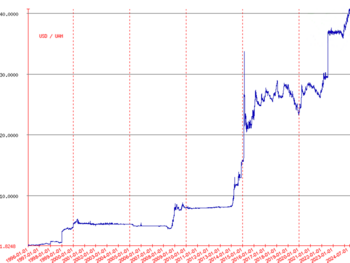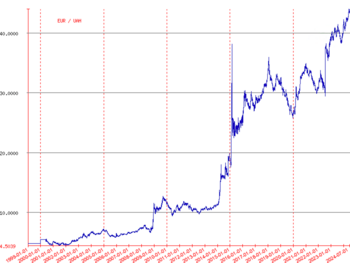Ukrainian hryvnia facts for kids
Quick facts for kids Ukrainian hryvnia |
||||
|---|---|---|---|---|
|
||||
| ISO 4217 Code | UAH | |||
| User(s) | ||||
| Inflation | 9.52% (2021 y-o-y) | |||
| Source | NBU, 2019, May | |||
| Method | CPI | |||
| Subunit | ||||
| 1⁄100 | kopiyka (копійка) | |||
| Symbol | ₴ or грн | |||
| Plural | hryvni (nom. pl.), hryven (gen. pl.) | |||
| kopiyka (копійка) | kopiyky (nom. pl.), kopiyok (gen. pl.) | |||
| Coins | ||||
| Freq. used | ₴1, ₴2, ₴5, ₴10 | |||
| Rarely used | 10, 50 kopiyok | |||
| Banknotes | ||||
| Freq. used | ₴20, ₴50, ₴100, ₴200, ₴500, ₴1,000 | |||
| Rarely used | ₴1, ₴2, ₴5, ₴10 | |||
| Printer | National Bank of Ukraine | |||
The Hryvnia (pronounced HRIHV-nee-uh) is the official money of Ukraine. It has been used since September 2, 1996. One hryvnia is made up of 100 smaller coins called kopiyok. The name "hryvnia" comes from an old unit of weight used in Kievan Rus', a powerful state that existed a long time ago.
Contents
What's in a Name? The Hryvnia's Story
The word "hryvnia" has a cool history! It comes from the word grivna, which was the money used in Kievan Rus' in the 11th century.
Where Did the Name "Hryvnia" Come From?
The word grivna likely comes from a Slavic word meaning "mane" (like a horse's hair). It might have referred to valuable items worn around the neck, often made of silver or gold. These items were similar to bracelets, which are called grivna in some languages.
After Ukraine became independent from Russia in 1917, the new country, the Ukrainian People's Republic, decided to name its money "hryvnia." This was a way to connect to the old grivna of Kievan Rus'. Famous artist Heorhiy Narbut designed these early banknotes.
How to Talk About Hryvnia: Plural Forms
When you talk about more than one hryvnia, the word changes.
- For numbers ending in 2, 3, or 4 (like 2, 3, 4, 22, 23, 24), you say hryvni. For example, dvi hryvni means "2 hryvni."
- For numbers ending in 5 to 9, or 0 (like 5, 10, 20, 100), you say hryven’. For example, sto hryven’ means "100 hryven’."
- For numbers ending in 1 (like 1, 21, 31), you use the singular form, hryvnia. For example, dvadtsiat’ odna hryvnia means "21 hryvnia."
- There's a special rule for numbers 11, 12, 13, and 14: you also use hryven’. So, dvanadciat’ hryven’ means "12 hryven’."
For the smaller coins, kopiyka is one coin. For more than one, you say kopiyky (like 2, 3, 4 kopiyky) or kopiyok (like 5, 10, 100 kopiyok).
The Hryvnia Symbol: ₴
The symbol for the hryvnia is a special Ukrainian letter "He" (which looks like г) with two lines across it (₴). These lines show that the currency is meant to be strong and stable. Other currencies like the Japanese yen (¥) and the euro (€) also use similar lines in their symbols.
This symbol was added to computer systems in 2005, so most computers can show it now. If the symbol isn't available, people in Ukraine often use the letters "грн" instead.
A Journey Through Time: The Hryvnia's History

On December 22, 1917, Ukraine created its own state bank. The first money of the Ukrainian People's Republic was called the karbovanets. The first 100 karbovanets banknote was printed on January 5, 1918.
Then, on March 1, 1918, a new currency, the hryvnia, was introduced. It was worth 100 shahs and half of the old karbovanets banknote.
However, in April 1918, Pavlo Skoropadskyi, a leader of Ukraine, brought back the karbovanets as the main currency.
During World War II, when Germany occupied Ukraine, they also printed karbovanets banknotes.
Later, in 1992, a third version of the karbovanets was used. But Ukraine faced a problem called hyperinflation in the early 1990s. This meant prices went up very, very quickly, and money lost its value fast.
To fix this, the hryvnia was introduced in September 1996. One hryvnia was worth 100,000 karbovanets!
The change to the hryvnia was done carefully. From September 2 to 16, 1996, both old karbovanets and new hryvnias could be used. But any change you received had to be in hryvnias. Banks automatically changed all money in accounts to hryvnias. Most of the old karbovanets were removed from use in just a few days. After September 16, you could still exchange old karbovanets for hryvnias at banks.
The first hryvnia banknotes were actually printed in 1992 by a Canadian company. But they were kept safe until the hyperinflation problem in Ukraine was under control.
In 2014, after Russia took over Crimea, the hryvnia was replaced by the Russian ruble there. In some parts of eastern Ukraine, the hryvnia continued to be used until 2022.
Coins of Ukraine
Ukraine's coins were first made in 1992, but they weren't used until September 1996. At first, coins from 1 to 50 kopiyky were released. Then, in March 1997, ₴1 coins were added. Special ₴1 coins have been made since 2004 to celebrate different events.
In 2012, the National Bank of Ukraine thought about stopping the production of 1 and 2 kopiyky coins because they were too expensive to make. After 2013, these coins were no longer made, and they stopped being official money on October 1, 2019. You can still exchange them at banks.
The National Bank also considered making a ₴2 coin. By July 2016, there were billions of coins in use! On October 1, 2019, 1, 2, and 5 kopiyky coins were officially taken out of circulation.
| Coins of the Ukrainian Hryvnia (1992–present) | ||||||||||||
|---|---|---|---|---|---|---|---|---|---|---|---|---|
| Image | Value | Technical parameters | Description | Date of | ||||||||
| Obverse | Reverse | Diameter | Mass | Composition | Edge | Obverse | Reverse | minting | issue | withdrawal | ||
 |
 |
1 kopiyka | 16 mm | 1.5 g | Stainless steel | Plain | Value, Ornaments |
Ukrainian Trident | 1992–2016 | 2 September 1996 | Not issued since 1 July 2018. 1, 2, and 5-kopiyka coins withdrew from general circulation on 1 October 2019. | |
 |
 |
2 kopiyky | 17.30 mm | 0.64 g (1992~1996) 1.8 g (2001–) |
aluminium (1992–1996), stainless steel (2001–) |
1992–2014 | ||||||
 |
 |
5 kopiyok | 24 mm | 4.3 g | stainless steel | Reeded | 1992–2015 | |||||
 |
 |
10 kopiyok | 16.3 mm | 1.7 g | brass (1992–1996), aluminium bronze (2001–) |
Reeded | Value, Ornaments |
Ukrainian Trident | 1992~present | 2 September 1996 | Current | |
 |
 |
25 kopiyok | 20.8 mm | 2.9 g | Reeded and plain sectors | 1992–2016 | Not issued since 1 July 2018. 25-kopiyka coin ceased to be legal tender in Ukraine and gone out of circulation, effective 1 October 2020. | |||||
 |
 |
50 kopiyok | 23 mm | 4.2 g | 1992~present | Current | ||||||
 |
 |
1 hryvnia | 26 mm | 7.1 g (1995,1996) 6.9 g (2001–) |
brass (1995, 1996), aluminium bronze (2001–) |
Inscription: "ОДНА ГРИВНЯ", minted year | 1995~2013 | 12 March 1997 | Current, but new design introduced in 2018 | |||
 |
 |
1 hryvnia | 26 mm | 6.8 g (2004–2016) | Aluminium bronze (2004–2016) | Plain with incuse lettering ("ОДНА · ГРИВНЯ · Date of issue") | Inscription: Coat of arms of Ukraine; УКРАЇНА 1 ГРИВНЯ; date of issue inside a decorative wreath | Half length figure of Volodymyr the Great holding a model church and staff with legend above | 2004–2016 | 2004 | ||
| 1 hryvnia | 18.9 mm | 3.3 g | Nickel-plated steel | Reeded | Coat of Arms of Ukraine, Value, Ornaments |
Volodymyr the Great | 2018 | Current | ||||
 |
 |
2 hryvni | 20.2 mm | 4.0 g | Yaroslav the Wise | |||||||
 |
 |
5 hryven | 22.1 mm | 5.2 g | Segmented (Plain and Reeded edges) | Bohdan Khmelnytsky | 2019 | |||||
 |
 |
10 hryven | 23.5 mm | 6.4 g | Nickel plated zinc alloy | Reeded | Ivan Mazepa | 2020 | ||||
| These images are to scale at 2.5 pixels per millimetre. For table standards, see the coin specification table. | ||||||||||||
Ukrainian Banknotes: Paper Money
In 1996, the first series of hryvnia banknotes (paper money) was put into use. These notes were actually printed in 1992. They came in values of 1, 2, 5, 10, and 20 hryvnias. Ukrainian artists Vasyl Lopata and Borys Maksymov designed them. The 1 hryvnia notes were printed in Canada. The 2, 5, and 10 hryvnia notes were printed two years later. All these banknotes were kept safe in Canada until they were needed.
There were also 50 and 100 hryvnia notes from this first series, but they weren't used because they weren't needed during the economic situation in the mid-1990s.
Later in 1996, new 1, 50, and 100 hryvnia notes were introduced. These were designed and printed by a British company called De La Rue. Since 1994, all Ukrainian banknotes have been printed in Ukraine.
Over time, higher value banknotes were added:
- 200 hryvnia notes in 2001.
- 500 hryvnia notes in 2006.
- 1000 hryvnia notes in 2019.
The 100, 200, and 500 hryvnia notes are very common. Many ATMs in Ukraine give out money in these amounts.
In 2016, the factory that makes paper for banknotes started using flax instead of cotton. This is a more sustainable way to produce the paper.
In 2019, the National Bank of Ukraine released a 1,000 hryvnia banknote. This was done to help simplify the number of different coins and banknotes in use. The 1, 2, 5, and 10 hryvnia banknotes are still official money, but they are slowly being taken out of circulation as coins of the same value are used more.
Also in 2019 and 2020, the National Bank updated the designs of the 50 and 200 hryvnia banknotes.
Current Banknote Designs
| Denomination [1] and dimensions |
Image | Main colour | Description | Date of issue | Withdrawal | |||
|---|---|---|---|---|---|---|---|---|
| Obverse | Reverse | Watermark | Obverse | Reverse | ||||
| ₴1 118 × 63 mm |
Yellow-blue | Volodymyr the Great of Kiev (c. 958–1015), Prince of Novgorod and Grand Prince of Kiev Ruler of Kievan Rus' in (980–1015) |
Volodymyr I's Fortress Wall in Kiev | 22 May 2006 | 1 October 2020 | |||
| ₴2 118 × 63 mm |
Terracotta | Yaroslav the Wise (c. 978 – 1054), Prince of Novgorod and Grand Prince of Kiev Ruler of Kievan Rus' in (1019–1054) |
Saint Sophia Cathedral, Kyiv | 24 September 2004 | ||||
| ₴5 118 × 63 mm |
Blue | Bohdan Khmelnytsky (c. 1595–1657), Hetman of Ukraine | A church in the village of Subotiv | 14 June 2004 | ||||
| ₴10 124 × 66 mm |
Crimson | Ivan Mazepa (1639–1709), Hetman of Ukraine | The Holy Dormition Cathedral of the Kyiv Pechersk Lavra | 1 November 2004 | ||||
| ₴20 130 × 69 mm |
Green | Ivan Franko (1856–1916), writer and politician | Lviv Theatre of Opera and Ballet | 25 September 2018 | Current | |||
| ₴50 136 × 72 mm |
 |
 |
Violet | Mykhailo Hrushevskyi (1866–1934), historian and politician. | The Tsentralna Rada building ("House of the Teacher" in Kyiv) | 20 December 2019 | ||
| ₴100 142 × 75 mm |
 |
 |
Olive | Taras Shevchenko (1814–1861), poet and artist | Taras Shevchenko National University of Kyiv | 9 March 2015 | ||
| ₴200 148 × 75 mm |
 |
 |
Pink | Lesya Ukrainka (1871–1913), poet and writer | Entrance Tower of Lutsk Castle | 25 February 2020 | ||
| ₴500 154 × 75 mm |
 |
 |
Brown | Hryhorii Skovoroda (1722–1794), philosopher and poet | National University of Kyiv-Mohyla Academy | 11 April 2016 | ||
| ₴1,000 160 × 75 mm |
 |
 |
Blue | Volodymyr Vernadskyi (1863–1945), historian, philosopher, naturalist and scientist | National Academy of Sciences of Ukraine | 25 October 2019 | ||
| These images are to scale at 0.7 pixel per millimetre. For table standards, see the banknote specification table. | ||||||||
How the Hryvnia's Value Changes
The value of money can change over time compared to other currencies. This is called the exchange rate.
When the hryvnia was first introduced, 1 US dollar was worth about 1.76 hryvnias.
After a big financial crisis in Asia in 1998, the hryvnia's value went down. By 2000, 1 US dollar was worth about 5.6 hryvnias. For a few years, the exchange rate stayed pretty stable.
In late 2008, during a global financial crisis, the hryvnia's value dropped quickly. It went from about 4.85 hryvnias per dollar to 7.88 hryvnias per dollar in just a few months. After that, it stayed around 8 hryvnias per dollar for several years.
In 2014, because of political changes in Ukraine, the National Bank of Ukraine decided to let the hryvnia's value float freely. This means its value changes based on the market, like how much people want to buy or sell it. In 2014 and 2015, the hryvnia lost a lot of its value against the US dollar, reaching a low of 33 hryvnias per dollar in February 2015.
By July 2019, the hryvnia became stronger again, with 1 US dollar being worth about 24.98 hryvnias.
After the Russian invasion of Ukraine in 2022, the official exchange rate was set at 29.25 hryvnias per US dollar. On July 21, 2022, it was changed to 36.5686 hryvnias per US dollar to match the market better.
The value of the hryvnia against other currencies, like the US dollar and the Euro, changes all the time.
| Year | USD | EUR | RUB | CHF | BTC |
|---|---|---|---|---|---|
| 2000 | 5.3345 | 4.9415 | 3.2246 | ||
| 2001 | 5.4125 | 4.4860 | 3.1871 | ||
| 2002 | 5.3304 | 5.0023 | 3.4288 | ||
| 2003 | 5.3318 | 6.1980 | 3.9614 | ||
| 2004 | 5.3072 | 6.9395 | 0.1986 | 4.2818 | |
| 2005 | 5.2799 | 6.1312 | 0.1805 | 4.1275 | |
| 2006 | 5.0500 | 6.3620 | 0.1843 | 4.0278 | |
| 2007 | 5.0500 | 7.0010 | 0.1943 | 4.2116 | |
| 2008 | 6.8777 | 8.9879 | 0.2433 | 4.8609 | |
| 2009 | 7.7038 | 11.2046 | 0.2619 | 7.1950 | 0.0000 |
| 2010 | 7.9356 | 10.5329 | 0.2610 | 7.6261 | 3.2992 |
| 2011 | 7.9930 | 11.0921 | 0.2720 | 9.0141 | 105.3409 |
| 2012 | 7.9880 | 10.2706 | 0.2570 | 8.5208 | 38.6018 |
| 2013 | 7.9930 | 10.6122 | 0.2510 | 8.6233 | 1,573.15 |
| 2014 | 12.2967 | 15.7159 | 0.3110 | 12.9501 | 5,428.19 |
| 2015 | 21.5751 | 24.2287 | 0.3620 | 22.6973 | 7,956.56 |
| 2016 | 25.2860 | 28.2919 | 0.3830 | 25.9546 | 13,427.58 |
| 2017 | 27.1194 | 30.0042 | 0.4560 | 26.9990 | 115,302.94 |
| 2018 | 27.4550 | 32.1429 | 0.4360 | 27.8305 | 219,979.42 |
| 2019 | 24.4558 | 28.9518 | 0.3990 | 26.0025 | 189,893.73 |
| 2020 | 25.4555 | 30.7900 | 0.3740 | 28.7600 | 313,830.20 |
| 2021 | 27.7235 | 32.3100 | 0.3700 | 29.8600 | 1,304,733.15 |
| 2022 | 34.5886 | 35.9210 | 0.4476 | 35.5610 | 815,943.77 |
| 2023 | 36.4136 | 38.3263 | 0.4054 | 40.1478 | 1,052,340.81 |
| 2024 | 38.3109 | 41.5476 | 0.4189 | 43.6031 | 1,818,454.39 |
| Current UAH exchange rates | |
|---|---|
| From Google Finance: | AUD CAD CHF EUR GBP HKD JPY USD |
| From Yahoo! Finance: | AUD CAD CHF EUR GBP HKD JPY USD |
| From XE.com: | AUD CAD CHF EUR GBP HKD JPY USD |
| From OANDA: | AUD CAD CHF EUR GBP HKD JPY USD |
| From fxtop.com: | AUD CAD CHF EUR GBP HKD JPY USD |
See also
 In Spanish: Grivna para niños
In Spanish: Grivna para niños
- Economy of Ukraine
- List of commemorative coins of Ukraine
- List of currencies in Europe
- Hryvnia






